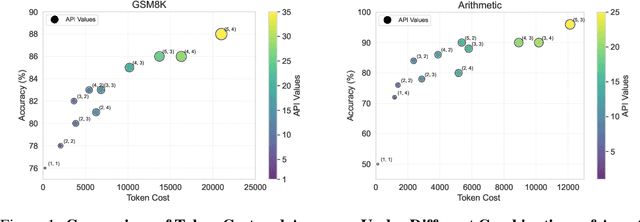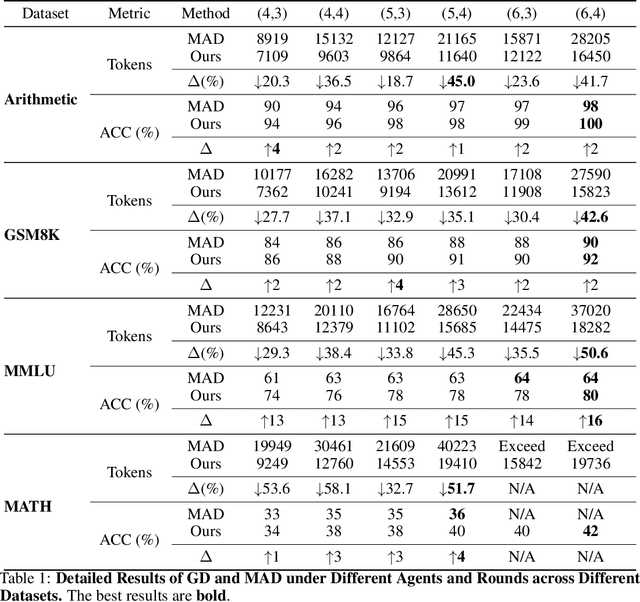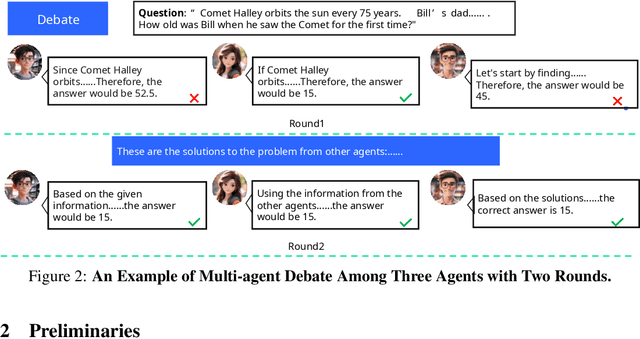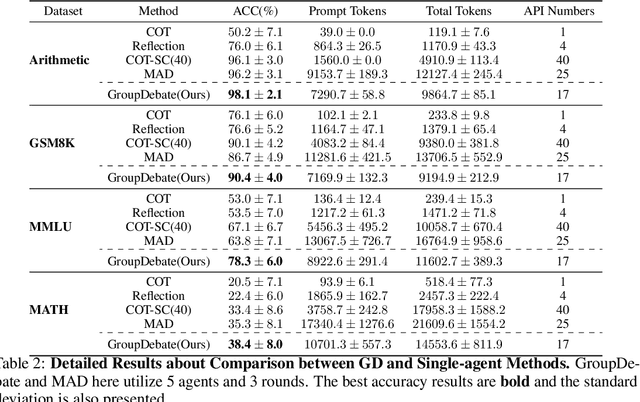Xingyu Wang
Chain-of-Talkers (CoTalk): Fast Human Annotation of Dense Image Captions
May 28, 2025Abstract:While densely annotated image captions significantly facilitate the learning of robust vision-language alignment, methodologies for systematically optimizing human annotation efforts remain underexplored. We introduce Chain-of-Talkers (CoTalk), an AI-in-the-loop methodology designed to maximize the number of annotated samples and improve their comprehensiveness under fixed budget constraints (e.g., total human annotation time). The framework is built upon two key insights. First, sequential annotation reduces redundant workload compared to conventional parallel annotation, as subsequent annotators only need to annotate the ``residual'' -- the missing visual information that previous annotations have not covered. Second, humans process textual input faster by reading while outputting annotations with much higher throughput via talking; thus a multimodal interface enables optimized efficiency. We evaluate our framework from two aspects: intrinsic evaluations that assess the comprehensiveness of semantic units, obtained by parsing detailed captions into object-attribute trees and analyzing their effective connections; extrinsic evaluation measures the practical usage of the annotated captions in facilitating vision-language alignment. Experiments with eight participants show our Chain-of-Talkers (CoTalk) improves annotation speed (0.42 vs. 0.30 units/sec) and retrieval performance (41.13\% vs. 40.52\%) over the parallel method.
HF-VTON: High-Fidelity Virtual Try-On via Consistent Geometric and Semantic Alignment
May 26, 2025Abstract:Virtual try-on technology has become increasingly important in the fashion and retail industries, enabling the generation of high-fidelity garment images that adapt seamlessly to target human models. While existing methods have achieved notable progress, they still face significant challenges in maintaining consistency across different poses. Specifically, geometric distortions lead to a lack of spatial consistency, mismatches in garment structure and texture across poses result in semantic inconsistency, and the loss or distortion of fine-grained details diminishes visual fidelity. To address these challenges, we propose HF-VTON, a novel framework that ensures high-fidelity virtual try-on performance across diverse poses. HF-VTON consists of three key modules: (1) the Appearance-Preserving Warp Alignment Module (APWAM), which aligns garments to human poses, addressing geometric deformations and ensuring spatial consistency; (2) the Semantic Representation and Comprehension Module (SRCM), which captures fine-grained garment attributes and multi-pose data to enhance semantic representation, maintaining structural, textural, and pattern consistency; and (3) the Multimodal Prior-Guided Appearance Generation Module (MPAGM), which integrates multimodal features and prior knowledge from pre-trained models to optimize appearance generation, ensuring both semantic and geometric consistency. Additionally, to overcome data limitations in existing benchmarks, we introduce the SAMP-VTONS dataset, featuring multi-pose pairs and rich textual annotations for a more comprehensive evaluation. Experimental results demonstrate that HF-VTON outperforms state-of-the-art methods on both VITON-HD and SAMP-VTONS, excelling in visual fidelity, semantic consistency, and detail preservation.
DocMMIR: A Framework for Document Multi-modal Information Retrieval
May 25, 2025Abstract:The rapid advancement of unsupervised representation learning and large-scale pre-trained vision-language models has significantly improved cross-modal retrieval tasks. However, existing multi-modal information retrieval (MMIR) studies lack a comprehensive exploration of document-level retrieval and suffer from the absence of cross-domain datasets at this granularity. To address this limitation, we introduce DocMMIR, a novel multi-modal document retrieval framework designed explicitly to unify diverse document formats and domains, including Wikipedia articles, scientific papers (arXiv), and presentation slides, within a comprehensive retrieval scenario. We construct a large-scale cross-domain multimodal benchmark, comprising 450K samples, which systematically integrates textual and visual information. Our comprehensive experimental analysis reveals substantial limitations in current state-of-the-art MLLMs (CLIP, BLIP2, SigLIP-2, ALIGN) when applied to our tasks, with only CLIP demonstrating reasonable zero-shot performance. Furthermore, we conduct a systematic investigation of training strategies, including cross-modal fusion methods and loss functions, and develop a tailored approach to train CLIP on our benchmark. This results in a +31% improvement in MRR@10 compared to the zero-shot baseline. All our data and code are released in https://github.com/J1mL1/DocMMIR.
TCC-Bench: Benchmarking the Traditional Chinese Culture Understanding Capabilities of MLLMs
May 19, 2025Abstract:Recent progress in Multimodal Large Language Models (MLLMs) have significantly enhanced the ability of artificial intelligence systems to understand and generate multimodal content. However, these models often exhibit limited effectiveness when applied to non-Western cultural contexts, which raises concerns about their wider applicability. To address this limitation, we propose the Traditional Chinese Culture understanding Benchmark (TCC-Bench), a bilingual (i.e., Chinese and English) Visual Question Answering (VQA) benchmark specifically designed for assessing the understanding of traditional Chinese culture by MLLMs. TCC-Bench comprises culturally rich and visually diverse data, incorporating images from museum artifacts, everyday life scenes, comics, and other culturally significant contexts. We adopt a semi-automated pipeline that utilizes GPT-4o in text-only mode to generate candidate questions, followed by human curation to ensure data quality and avoid potential data leakage. The benchmark also avoids language bias by preventing direct disclosure of cultural concepts within question texts. Experimental evaluations across a wide range of MLLMs demonstrate that current models still face significant challenges when reasoning about culturally grounded visual content. The results highlight the need for further research in developing culturally inclusive and context-aware multimodal systems. The code and data can be found at: https://tcc-bench.github.io/.
Multi-agent Multi-armed Bandit with Fully Heavy-tailed Dynamics
Jan 31, 2025Abstract:We study decentralized multi-agent multi-armed bandits in fully heavy-tailed settings, where clients communicate over sparse random graphs with heavy-tailed degree distributions and observe heavy-tailed (homogeneous or heterogeneous) reward distributions with potentially infinite variance. The objective is to maximize system performance by pulling the globally optimal arm with the highest global reward mean across all clients. We are the first to address such fully heavy-tailed scenarios, which capture the dynamics and challenges in communication and inference among multiple clients in real-world systems. In homogeneous settings, our algorithmic framework exploits hub-like structures unique to heavy-tailed graphs, allowing clients to aggregate rewards and reduce noises via hub estimators when constructing UCB indices; under $M$ clients and degree distributions with power-law index $\alpha > 1$, our algorithm attains a regret bound (almost) of order $O(M^{1 -\frac{1}{\alpha}} \log{T})$. Under heterogeneous rewards, clients synchronize by communicating with neighbors, aggregating exchanged estimators in UCB indices; With our newly established information delay bounds on sparse random graphs, we prove a regret bound of $O(M \log{T})$. Our results improve upon existing work, which only address time-invariant connected graphs, or light-tailed dynamics in dense graphs and rewards.
RoboMIND: Benchmark on Multi-embodiment Intelligence Normative Data for Robot Manipulation
Dec 18, 2024Abstract:Developing robust and general-purpose robotic manipulation policies is a key goal in the field of robotics. To achieve effective generalization, it is essential to construct comprehensive datasets that encompass a large number of demonstration trajectories and diverse tasks. Unlike vision or language data that can be collected from the Internet, robotic datasets require detailed observations and manipulation actions, necessitating significant investment in hardware-software infrastructure and human labor. While existing works have focused on assembling various individual robot datasets, there remains a lack of a unified data collection standard and insufficient diversity in tasks, scenarios, and robot types. In this paper, we introduce RoboMIND (Multi-embodiment Intelligence Normative Data for Robot manipulation), featuring 55k real-world demonstration trajectories across 279 diverse tasks involving 61 different object classes. RoboMIND is collected through human teleoperation and encompasses comprehensive robotic-related information, including multi-view RGB-D images, proprioceptive robot state information, end effector details, and linguistic task descriptions. To ensure dataset consistency and reliability during policy learning, RoboMIND is built on a unified data collection platform and standardized protocol, covering four distinct robotic embodiments. We provide a thorough quantitative and qualitative analysis of RoboMIND across multiple dimensions, offering detailed insights into the diversity of our datasets. In our experiments, we conduct extensive real-world testing with four state-of-the-art imitation learning methods, demonstrating that training with RoboMIND data results in a high manipulation success rate and strong generalization. Our project is at https://x-humanoid-robomind.github.io/.
Benchmarking Multimodal Retrieval Augmented Generation with Dynamic VQA Dataset and Self-adaptive Planning Agent
Nov 05, 2024



Abstract:Multimodal Retrieval Augmented Generation (mRAG) plays an important role in mitigating the "hallucination" issue inherent in multimodal large language models (MLLMs). Although promising, existing heuristic mRAGs typically predefined fixed retrieval processes, which causes two issues: (1) Non-adaptive Retrieval Queries. (2) Overloaded Retrieval Queries. However, these flaws cannot be adequately reflected by current knowledge-seeking visual question answering (VQA) datasets, since the most required knowledge can be readily obtained with a standard two-step retrieval. To bridge the dataset gap, we first construct Dyn-VQA dataset, consisting of three types of "dynamic" questions, which require complex knowledge retrieval strategies variable in query, tool, and time: (1) Questions with rapidly changing answers. (2) Questions requiring multi-modal knowledge. (3) Multi-hop questions. Experiments on Dyn-VQA reveal that existing heuristic mRAGs struggle to provide sufficient and precisely relevant knowledge for dynamic questions due to their rigid retrieval processes. Hence, we further propose the first self-adaptive planning agent for multimodal retrieval, OmniSearch. The underlying idea is to emulate the human behavior in question solution which dynamically decomposes complex multimodal questions into sub-question chains with retrieval action. Extensive experiments prove the effectiveness of our OmniSearch, also provide direction for advancing mRAG. The code and dataset will be open-sourced at https://github.com/Alibaba-NLP/OmniSearch.
Logic-of-Thought: Injecting Logic into Contexts for Full Reasoning in Large Language Models
Sep 26, 2024



Abstract:Large Language Models (LLMs) have demonstrated remarkable capabilities across various tasks but their performance in complex logical reasoning tasks remains unsatisfactory. Although some prompting methods, such as Chain-of-Thought, can improve the reasoning ability of LLMs to some extent, they suffer from an unfaithful issue where derived conclusions may not align with the generated reasoning chain. To address this issue, some studies employ the approach of propositional logic to further enhance logical reasoning abilities of LLMs. However, the potential omissions in the extraction of logical expressions in these methods can cause information loss in the logical reasoning process, thereby generating incorrect results. To this end, we propose Logic-of-Thought (LoT) prompting which employs propositional logic to generate expanded logical information from input context, and utilizes the generated logical information as an additional augmentation to the input prompts, thereby enhancing the capability of logical reasoning. The LoT is orthogonal to existing prompting methods and can be seamlessly integrated with them. Extensive experiments demonstrate that LoT boosts the performance of various prompting methods with a striking margin across five logical reasoning tasks. In particular, the LoT enhances Chain-of-Thought's performance on the ReClor dataset by +4.35%; moreover, it improves Chain-of-Thought with Self-Consistency's performance on LogiQA by +5%; additionally, it boosts performance of Tree-of-Thoughts on ProofWriter dataset by +8%.
GroupDebate: Enhancing the Efficiency of Multi-Agent Debate Using Group Discussion
Sep 21, 2024



Abstract:In recent years, Large Language Models (LLMs) have demonstrated remarkable capabilities across diverse NLP tasks. Extensive research has explored how to enhance the logical reasoning abilities such as Chain-of-Thought, Chain-of-Thought with Self-Consistency, Tree-Of-Thoughts, and multi-agent debates. In the context of multi-agent debates, significant performance improvements can be achieved with an increasing number of agents and debate rounds. However, the escalation in the number of agents and debate rounds can drastically raise the tokens cost of debates, thereby limiting the scalability of the multi-agent debate technique. To better harness the advantages of multi-agent debates in logical reasoning tasks, this paper proposes a method to significantly reduce token cost in multi-agent debates. This approach involves dividing all agents into multiple debate groups, with agents engaging in debates within their respective groups and sharing interim debate results between groups. Comparative experiments across multiple datasets have demonstrated that this method can reduce the total tokens by up to 51.7% during debates and while potentially enhancing accuracy by as much as 25%. Our method significantly enhances the performance and efficiency of interactions in the multi-agent debate.
VersiCode: Towards Version-controllable Code Generation
Jun 11, 2024



Abstract:Significant research has focused on improving the performance of large language model on code-related tasks due to their practical importance. Although performance is typically evaluated using public benchmark datasets, the existing datasets do not account for the concept of \emph{version}, which is crucial in professional software development. In this paper, we introduce VersiCode, the first comprehensive dataset designed to assess the ability of large language models to generate verifiable code for specific library versions. VersiCode encompasses 300 libraries across more than 2,000 versions spanning 9 years. We design two dedicated evaluation tasks: version-specific code completion (VSCC) and version-aware code editing (VACE). Comprehensive experiments are conducted to benchmark the performance of LLMs, revealing the challenging nature of these tasks and VersiCode, that even state-of-the-art LLMs struggle to generate version-correct code. This dataset, together with the proposed tasks, sheds light on LLMs' capabilities and limitations in handling version-specific code generation, and opens up an important new area of research for further investigation. The resources can be found at https://github.com/wutong8023/VersiCode.
 Add to Chrome
Add to Chrome Add to Firefox
Add to Firefox Add to Edge
Add to Edge